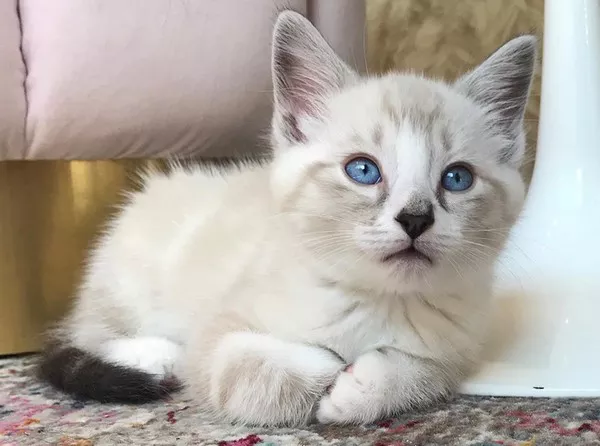The Egyptian Mau is one of the oldest and most intriguing domestic cat breeds, known for its striking appearance and playful personality. Recognizing this breed involves paying attention to a range of physical characteristics and behavioral traits. In this comprehensive guide, we will walk you through ten essential steps to identify an Egyptian Mau. Each step highlights key features and details that distinguish the Mau from other cat breeds.
1. Observe the Egyptian Mau Overall Body Structure
The first step in identifying an Egyptian Mau is to observe the cat’s overall body structure. The Egyptian Mau is a medium-sized cat with a well-muscled body. Unlike many other breeds, the Mau’s body is lean but not skinny, showcasing a balance between strength and elegance.
Key Points:
Size: Medium, with males weighing between 10-14 pounds and females slightly lighter at 6-10 pounds.
Musculature: Well-defined and athletic, indicating the cat’s natural agility and speed.
Body Length: Moderately long, contributing to a graceful yet powerful appearance.
2. Examine the Coat Pattern and Texture
One of the most distinctive features of the Egyptian Mau is its coat pattern and texture. The Mau’s coat is spotted, which is a rarity among domestic cats. These spots vary in size and shape and are randomly distributed across the body.
Key Points:
Spots: Look for randomly distributed spots that can be large or small. These spots should not form any regular pattern.
Texture: The coat is silky and comes in two types – medium-length and fine.
Color Variations: Common colors include silver, bronze, and smoke. Each color variant has its unique pattern and appearance.
3. Inspect the Head Shape and Facial Features
The head of an Egyptian Mau is distinctive, contributing significantly to its identification. The head is a slightly rounded wedge without flat planes, giving it a unique shape among cat breeds.
Key Points:
Head Shape: Slightly rounded wedge with no flat planes, tapering to a gently rounded muzzle.
Eyes: Large, almond-shaped, and set at a slight angle. The color is a striking gooseberry green.
Ears: Medium to large, broad at the base, and slightly pointed at the tips. Ears should have a wide set on the head.
4. Assess the Eyes and Eye Color
The Egyptian Mau’s eyes are one of its most captivating features. The eye color is a vivid gooseberry green, which is a clear indicator of the breed.
Key Points:
Shape and Set: Eyes are large, almond-shaped, and slightly slanted towards the base of the ears.
Color: The eyes should be a striking gooseberry green. This color is unique to the Egyptian Mau and is a definitive trait.
See Also: Tabby Cat vs Egyptian Mau: What’s The Difference?
5. Observe the Legs and Feet
The legs and feet of the Egyptian Mau contribute to its graceful appearance. The hind legs are slightly longer than the front legs, giving the cat a distinctive posture and gait.
Key Points:
Leg Length: Hind legs are longer than the front legs, leading to a cheetah-like gait.
Feet: Small and dainty, with slightly oval shapes. The toes are compact and close together.
6. Notice the Tail Characteristics
The tail of the Egyptian Mau is another important identifying feature. It should be medium in length, with a thick base that tapers to a point.
Key Points:
Length: Medium, proportionate to the body length.
Shape: Thick at the base and tapering to a pointed tip.
Pattern: Typically banded with rings and ending in a dark tip, consistent with the coat’s spotting.
7. Evaluate the Cat’s Behavior and Temperament
Behavior and temperament are crucial in identifying an Egyptian Mau. This breed is known for its active, playful nature and strong bond with humans.
Key Points:
Activity Level: Highly active and playful, enjoys engaging in games and activities.
Affection: Forms strong bonds with family members, often choosing a favorite person.
Vocalization: Known for being quite vocal, with a range of sounds to communicate with humans.
8. Check for Physical Markings
Specific physical markings are unique to the Egyptian Mau. These include the “M” shape on the forehead and mascara-like markings around the eyes.
Key Points:
Forehead Marking: Look for an “M” shape on the forehead, a common trait in tabby-patterned cats.
Eye Markings: Dark lines running from the eyes to the back of the head, resembling mascara.
9. Consider the Genetic Background
The genetic background of the Egyptian Mau is integral to its identification. This breed is one of the few naturally spotted breeds, and its lineage traces back to ancient Egypt.
Key Points:
Origins: Believed to have descended from cats depicted in ancient Egyptian art.
Spontaneous Mutation: The breed’s spotted coat pattern is a result of a natural mutation.
10. Verify with Breeder or Pedigree Information
For a definitive identification, consult with a breeder or refer to pedigree information. Reputable breeders can provide documentation and verification of the cat’s lineage.
Key Points:
Breeder Consultation: A certified breeder can confirm the cat’s breed based on pedigree records.
Documentation: Check for official pedigree papers that trace the cat’s lineage and confirm its status as an Egyptian Mau.
Conclusion
Identifying an Egyptian Mau requires a keen eye for detail and an understanding of the breed’s unique characteristics. From its distinctive coat pattern and eye color to its playful temperament and historical background, the Mau is a remarkable breed with many identifiable features. By following these ten steps, you can confidently distinguish an Egyptian Mau from other cat breeds, ensuring a deeper appreciation for this ancient and beautiful feline.
Related Topics:


























